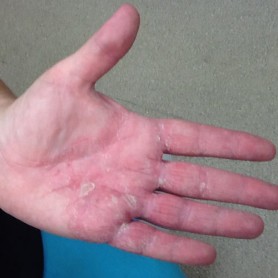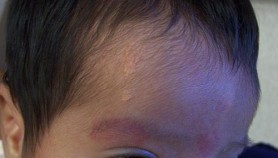What is Eczema and Dermatitis?
Eczema is a fairly generic term which really means a red, itchy, scaly rash. Actually I have a textbook eczema that’s this thick. So there’s many, many types of eczema that we can talk about.
So If you’re a new patient with eczema, the first thing I’m going to do is sit you down and just get the history of how long you’ve had it, which areas of the body are the ones that are flaring up, and what your triggers are to try and figure out if it’s seborrheic dermatitis, or if it’s something you’re getting exposed to at work or school. So I’ll try and figure out from your history what type of eczema or dermatitis you have.
Once we’ve done that, then I can tell you which things to avoid which may be playing a role, and then we’ll start talking about treatment. And again, the guiding principles of eczema that I talked about before; keeping the baths and showers short, using lukewarm water, using a gentle soap such as Dove or Oil of Olay, and lots of moisturizing after shower and bath. Those are really the guiding fundamental parts of treating eczema.
And then for a more aggressive treatment, we’ll use a topical corticosteriod creams. I’ll write you a prescription for a cream that I think is the right strength based on the severity of your eczema and for the right body, and I’ll give you some guidance as to how long you can safely use it.
Types of Eczema and Dermatitis
Allergic Contact Dermatitis
Contact dermatitis, of which you can have an irritant contact dermatitis, which means some sort of chemical or outside source that causes an itchy, red, and scaly rash on the skin that would affect everyone because of its irritant nature, versus an allergic contact dermatitis, which is something that you are sensitized to. An allergic contact dermatitis is something that we see fairly often. It will present with red, itchy, scaly rashes, and a very well demarcated pattern which is based on the contact that you have. And some common sources are nickel and some metals that are found in things that we wear, black dye, or paraphenylenediamine which is found in some of the over-the-counter black dyes, or even henna tattoos that people like to get. We often see allergic contact dermatitis from formaldehyde, which is a preservative that’s found in a lot of over-the-counter cosmetic products and a lot of visual eye-drops.
So when you have contact dermatitis, no matter what the cause is, the most important thing is to try and remove the cause. If you remove what’s causing it, the dermatitis will go away on its own. But ultimately you’ll end up here because it is uncomfortable with the itching and the scratching. And we’ll typically give you topical corticosteroid creams to calm it down.
There are many chemicals in our environment which can cause allergic contact dermatitis. Examples include nickel, fragrances, hair dyes, preservatives, rubber, and latex products. The hallmark of allergic contact dermatitis is that only some people exposed to the allergen will develop dermatitis. If a rash that appears to be allergic contact dermatitis emerges, a careful history and physical may be all that is required to uncover the culprit. However in some cases, more extensive usage testing or patch testing may be needed in order to achieve an accurate diagnosis.
Atopic Dermatitis
Called “the scratch that itches,” atopic dermatitis is an immunologic disease of hyper-reactivity of the skin to many external substances. Scratching often leads to redness, swelling, cracking, blistering or “weeping” of clear fluid, and scaling of the skin. Atopic dermatitis is an inherited tendency and is associated with asthma and hay fever. Just as the appearance of eczema and the exacerbating factors vary from one person to another, so do the treatment options.
Hand Eczema
Any type of eczema that forms on the hands is considered hand eczema and may require a different treatment approach. Hand eczema is extremely common due to constant exposure to multiple irritants: air, water, harsh soaps, cleaning agents, chemicals and solvents.
Irritant Contact Dermatitis
Some compounds cause eczema on exposure because they are irritating and/or drying. Examples of these would be items such as harsh soaps, cleansers, or solvents. Unlike allergic contact reactions which only affect a small proportion of those exposed, a true irritant dermatitis will affect anybody who has adequate exposure to the chemical.
Neurodermatitis
This type of eczema starts as an itchy patch of skin that if scratched, can irritate the nerve endings in the skin. This increases the itchy sensation, eventually leading to the cycle of chronic itching.
Nummular Dermatitis
Nummular dermatitis creates coin-shaped marks which appear on the skin. Overtime, these spots become itchy and cause the area to become crusty or filled with pus. This chronic condition is usually experienced after a skin injury or insect bite.
Pediatric Atopic Dermatitis
Atopic dermatitis is basically eczema in children and babies. That probably affects about 10 to 20% of the population. That commonly presents with a baby with a red, itchy, scaly rash typically in the flexural folds, so over here and behind the knees. This can be quite a problem for the patient and the family, because the baby is often up all night itching and scratching and crying.
So there are certain fundamental aspects of treating pediatric-atopic dermatitis, and a lot of these go over to treating all eczema and dermatitis. But basically with these patients, you want to keep the showers or the baths really short. Two or three minutes, get in, get out. You want to use lukewarm water, not super hot, not super cold. You want to use a gentle soap, such as Cetaphil or CeraVe, and when you get out, you want to pat yourself dry. You don’t want to rub with the towel because it strips the skin barrier. And then you want to take your thick blend emollients moisturizer and seal that water back in. We usually recommend things such as Cetaphil, or CeraVe, or Eucerin, or even Aquaphor.
So all of those principles are very important for atopic dermatitis, but really for all forms of eczema. For patients that are flaring, we’ll often use again the topical corticosteriod creams. And again these are safe in babies and children if you’re picking the right dose as recommended by a dermatologist and following the directions. Sometimes we use oral antihistamines, or topical, or prescription anti-H agents to kind of break that itch-scratch cycle.
Antibiotics often play a role in our treatment of eczema. As I mentioned, eczema is a very itchy condition, and sometimes with this itching and scratching people with eczema are prone to secondary staph infections. So a lot of times, when eczema is flaring and is not necessarily responding to the treatments I have gone through already, we’ll often add an oral antibiotic to kind of treat the staph that’s flaring up the eczema.
In children red, itchy patches that often lead to cracking of the skin tend to develop on the cheeks, back of the knee and inside of the elbow. When atopic dermatitis develops in an infant or young child, the child tends to get better with age.
Seborrheic Dermatitis
Seborrheic dermatitis is actually one of the most common reasons that an adult patient will visit the dermatologist. Probably affects 10 to 20% of the population. It will typically present with red, itchy, scaly patches in the parts of the face and upper body that have a lot of oil glands. So typically over here, and over here, and over here and here. And it’s really bad in and behind the ears, and even on the scalp and the chest.
So, although there’s no cure for seborrheic dermatitis, and it’s something that will tend to come and go, particularly in times of stress, we have a lot of medicines that can control it and give you the tools to keep it under control. The most common tool is usually going to be a topical corticosteriod cream, which we’ll have you use for a week or two whenever it’s flaring. And that usually calms it down. In some patients… We all have yeast that grows on our body, but in some patients they have too much of this yeast in their oil glands. So in seborrheic dermatitis that’s a little bit difficult to control. We’ll often add a cream or a gel that attacks this yeast component that usually can bridge the gap in treatment.
Seborrheic dermatitis produces red, oily, scaly itchy patches on the scalp, eyebrows, sides of nose or ear caused by a yeast-like organism that lives on the skin. Seborrheic dermatitis is common in babies (commonly called cradle cap), but can be present in patients of any age.
Stasis Dermatitis
Stasis dermatitis is a type of eczema or dermatitis that we typically see in our senior patients. Basically, in our veins we have valves that are like a V and they block the blood from going backwards. As we age, those valves get a little bit incompetent and the blood back flows, and when those red blood cells filter into the skin and the body breaks that down, it causes the type of dermatitis that typically we’ll see on the lower legs. And that’s very common in our senior patients. So some things that are important for patients with stasis dermatitis, we tell them that they need to keep their legs elevated, above the level of the heart as long as possible.
When they’re watching TV or reading or on the computer, because that helps to move the blood back through the veins; back into the circulation. If they’re going to be out for long periods of time or on a long airplane flight we’ll often recommend compression hose. Again, because that’s pushing the blood back through the venous system.
When stasis dermatitis is flaring of course like all the forms of eczema that we’ve talked about it’s going to be itchy and scaly and red. We’ll use our mainstay of eczema treatment which is the topical corticosteroid creams typically for two or three weeks to calm it down. And then once it’s under control, we’ll go back to our maintenance regimen which again is a common theme with eczema where we’ll use a bland emollient such as Eucerin or CeraVe or Aquaphor on a daily basis.
Stasis dermatitis arises when the skin becomes severely inflamed. The extreme skin inflammation is caused by the lack of blood flow in the veins of the leg. This can cause pooling of blood in the legs, which increases the difficulty of blood circulation to the heart. Those who suffer from stasis dermatitis will notice thin, brown areas of the skin, accompanied by itchy and swollen legs. If you experience any of these symptoms, it’s important to get in touch with our expert dermatologists to determine the cause and help to narrow down your treatment options. Below are a few of the treatment options that we offer at Arizona Dermatology for eczema and eczema-related diseases.
No matter which type of eczema or dermatitis you have, it’s important to come see one of our board certified dermatologists to correctly identify the condition. Based on your symptoms, budget and needs, we will work with you to find the best treatment option for you:





